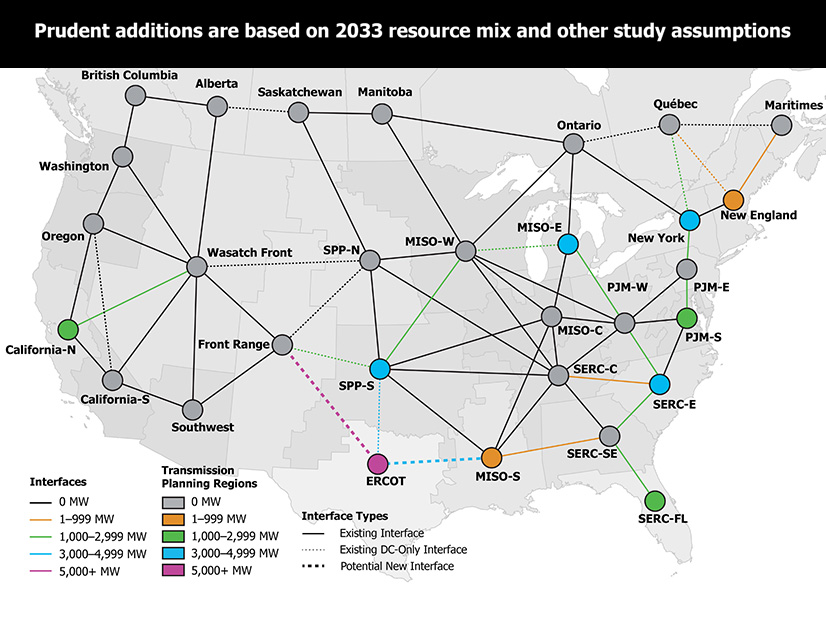
In the final installments of the Interregional Transfer Capability Study (ITCS), released this week, NERC called for “a diverse and flexible approach” to meeting the future transfer needs of the U.S. electric grid.
NERC released the second and third draft ITCS installments on schedule Nov. 4. Part 1 of the study, released in draft form Aug. 28, comprised a transfer capability analysis summing up the current transfer capabilities between transmission planning regions in North America. (See NERC Examines Transfer Capability in Draft ITCS Installment.)
Part 2 includes recommendations for prudent additions to transfer capability that could strengthen grid reliability, while Part 3 lays out recommendations to meet and maintain total transfer capability. The three installments will be combined and submitted to FERC by Dec. 2 as ordered by Congress in the Fiscal Responsibility Act of 2023. (See Lawmakers, White House Promise More Work on Permitting After Debt Deal.) FERC will post the report for public comment and then submit a report to Congress along with recommendations for statutory changes.
A fourth document will follow in the first quarter of 2025, covering transfer capabilities and prudent additions from the U.S. to Canada and between Canadian provinces. While this plan goes beyond Congress’ mandate, NERC said earlier this year that the study “would be incomplete without a thorough understanding of the Canadian limits and available resources.”
“The ITCS emphasizes a balanced approach — one that identifies the unique needs of each region and determines where targeted and meaningful investments can make a real difference in ensuring reliability and resilience,” NERC Director of Reliability Assessments and Performance Analysis John Moura said in a statement. He added that NERC would continue “to ensure the [electric grid] is prepared for tomorrow’s challenges without taking a one-size-fits-all approach.”
NERC’s recommended prudent additions were based on the transfer capability analysis in Part 1, which used the transmission planning regions identified in FERC Order 1000 to create two different base cases covering summer 2024 and winter 2024/25. The model mapped existing interfaces, along with potential new interfaces that might be constructed in the coming decade, and used historical weather data to estimate load and resource availability for the future.
NERC defined “prudent additions” as “transmission enhancements … to mitigate grid reliability risks under the most challenging conditions.” Economic issues and cost-benefit analysis were not considered in the analysis.
ITCS authors selected the 2033 resource mix as the basis for their projections, even though interregional transmission projects typically need at least 10 years for construction, because “forecasting demand and resources beyond that time frame becomes increasingly speculative and uncertain.” The impact of added transfer capability during extreme events was then evaluated using a six-step process:
-
- identify hours of resource deficiency through calculating available generation and storage, subtracting load and factoring in existing transfer capacity;
- quantify maximum resource deficiency by calculating the yearly maximum resource deficiency across 12 weather years;
- identify and prioritize constrained interfaces;
- allocate additional transfer capability across constrained interfaces;
- iterate incremental additions until all resource deficiencies are resolved, if possible; and
- finalize prudent levels of transfer capability.
The authors recommended a total of 35 GW of additional transfer capability across the planning regions studied, with the greatest amount — 14,100 MW — found in ERCOT across the SPP-South connection (4,100 MW) and two entirely new connections to Front Range (5,700 MW) and MISO-South (4,300 MW). NERC noted that even with these prudent additions, it was still not possible to resolve all energy deficiencies “due to wide-area resource shortages.”
The same was true in the California-North region, where the report recommended 1,100 MW of additions on the Wasatch Front connection.
NERC described “various options” that entities can use to mitigate the risks identified in the report and address the recommended additions. Among these are the development of internal resources such as generation and storage, which can reduce the need for external transfers; building new transmission lines or increasing transfer capability with neighboring regions; and demand-side management and resilience initiatives.
“While the study highlights specific needs to improve resilience under extreme conditions, NERC encourages flexibility in meeting these needs through various pathways,” the ERO said, suggesting “enhanced collaboration with regional planning entities, careful alignment with FERC and state policies, and consistent stakeholder engagement to effectively assess, refine and execute strategies.”
In addition, NERC emphasized that “a one-size-fits-all approach may not be solely effective” in overcoming transmission constraints; in particular, the ERO said that a blanket universal transfer capability minimum across regions “could lead to inefficient investments” in areas where transmission capability is already adequate or excessive.
NERC said it hoped the ITCS would “foster collaboration between utilities, regional planning organizations and state regulators” to tackle the transmission challenges facing the grid. It also suggested revisiting the ITCS in the future to account for advances in technology and changes to the resource mix.


